The clarinet is one of the most versatile and expressive instruments in the woodwind family. It can play in many musical genres from classical to jazz and pop. Once of the challenges and joys of the clarinet is that it can play in different keys, depending on the type. This means that clarinettists need to know how to transpose from one key to another to play in ensembles and to expand repertoire.
In this article, we’ll dive into transposition for clarinet in B flat, so you can level up your musical skills and play in ensembles in the right key!

The Clarinet in B Flat
The clarinet in B flat is the most popular type of clarinet. Like all clarinets, it is a transposing instrument so the note we hear is different to the note the clarinettist plays.
When the player reads a C on the staff and play a C, we hear a B flat. In other words, the clarinet’s written pitch is a major 2nd above their sounding pitch.
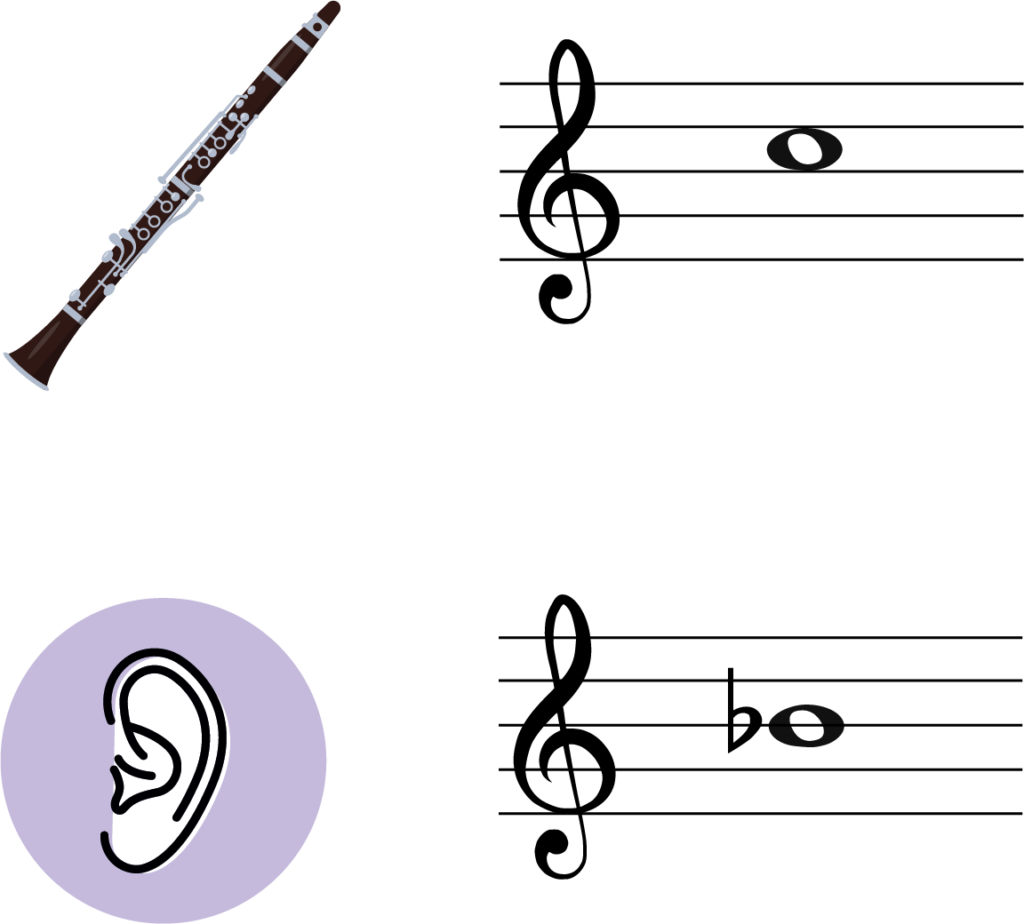
If you play the clarinet and you want to compose music that harmonises with the piano, your sheet music will be a major 2nd above the notes in the piano’s sheet music (or any other non-transposing instrument). Or you may want to play a flute piece on your clarinet, so you will have to raise each note a major 2nd (a whole step) to play it in the same key as the flute did.
Another use would be if you are a flute player and you want to play a piece written for clarinet. To play in the same key as the clarinet you would need to lower the music a whole step (a major 2nd).
Transpose Bb to C: A Step-by-Step Guide
Being able to transpose from B flat to C is a great skill to have for any musician. It will allow you to play pieces written for transposing instruments, like the clarinet and trumpet, and piece together ensembles so that everyone is playing in the same key!
Transposition is a tricky subject and it is really easy to make a mistake. But don’t worry, I have your back, so let’s look at being able to transpose from B flat to C.
Transposition for clarinet In B Flat to Piano
The piano is in concert pitch (the key of C) so we are going to have to transpose between Bb and C, or by a major 2nd.
Transposing from B flat to C involves up moving the notes up two half-steps (semitones) or one whole-step (tone). This is the same as moving up an interval of a Major 2nd as C natural is the 2nd note in the B flat major scale.
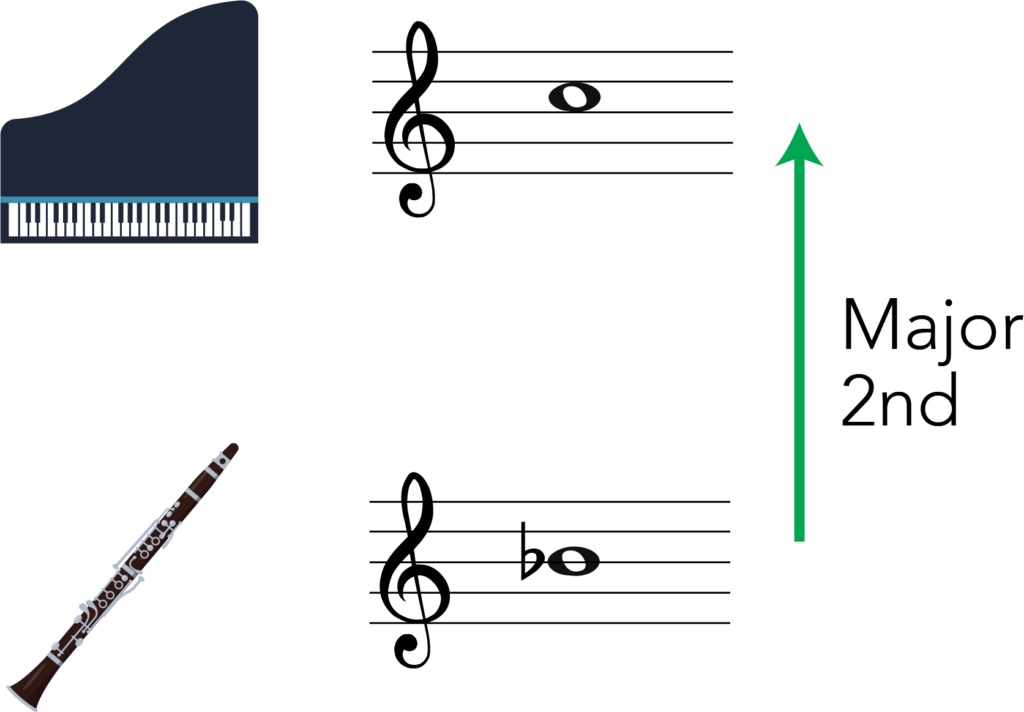
There are two different methods to transpose from B flat to C.
Method 1- Move notes up one at a time
Have a look at the melody below.

The melody is written in key of D major. We could move all the notes up a whole-step, making sure that we take into account the F# and C# notes in the original key.
Here is the new melody. As you can see, we now have four sharps, so we are in the key of E Major.

Here is the new melody with the correct key signature.

Method 2 – Transpose the key signature
- We could move up all the notes up a whole step
- Transpose the key signature up a major 2nd
- Deal with any notes outside the original key
Look at the melody below.

It is in Eb major so we have Bb, Eb and Ab. First let’s move all the notes up a whole step.

Now we can transpose our key signature. A whole step (tone) above Eb is F. Another way to put this is that a major 2nd above Eb is F natural. So our new key signature is for F Major, which has a B flat.
Here is our transposed melody with the new key signature.

Below is the full transposition for clarinet in B flat with the original melody and new melody.
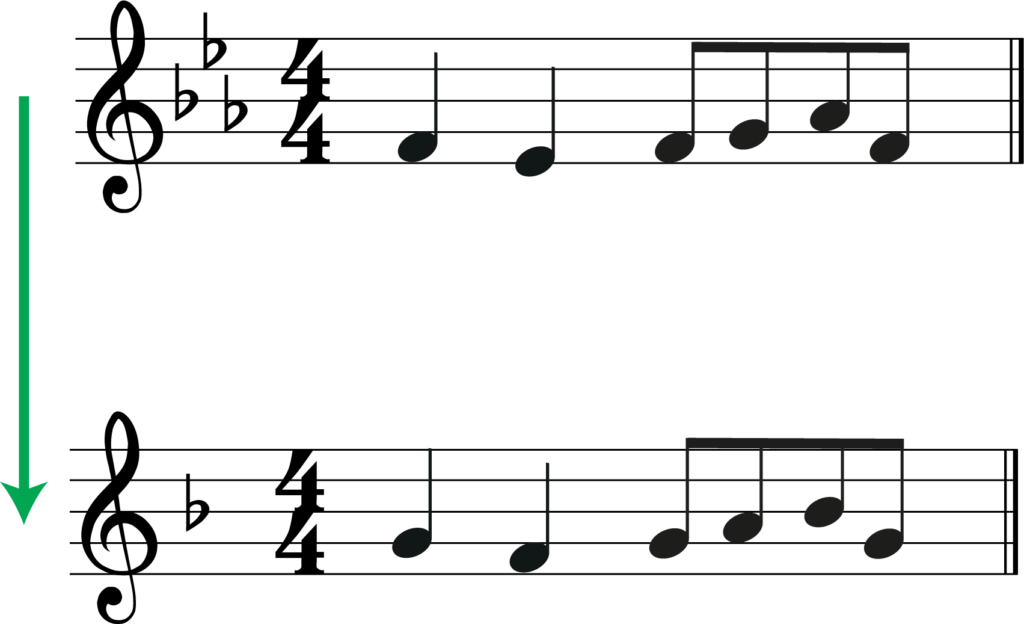
If there were any accidentals that were outside the key of Eb, we would not use this method. Instead we would treat them as individual notes and transpose them on their own. So if we had a C# then this would move up to a D# (a whole step above).
Both these methods work when either transposing up or down a major 2nd.
Clarinet B flat transposition chart
Here is a handy chart for helping you with transposition for clarinet in b flat. You can use it to transpose a single note, for example C to D, or you can use it to transpose the key signature of a piece. For example a piece in D Major would transpose up a major 2nd to E Major.

How to transpose clarinet to flute
The flute is a non-transposing instrument that plays in concert pitch, or in the key of C. This means that like with the piano, we have to transpose by a major 2nd to move between clarinet and flute music.
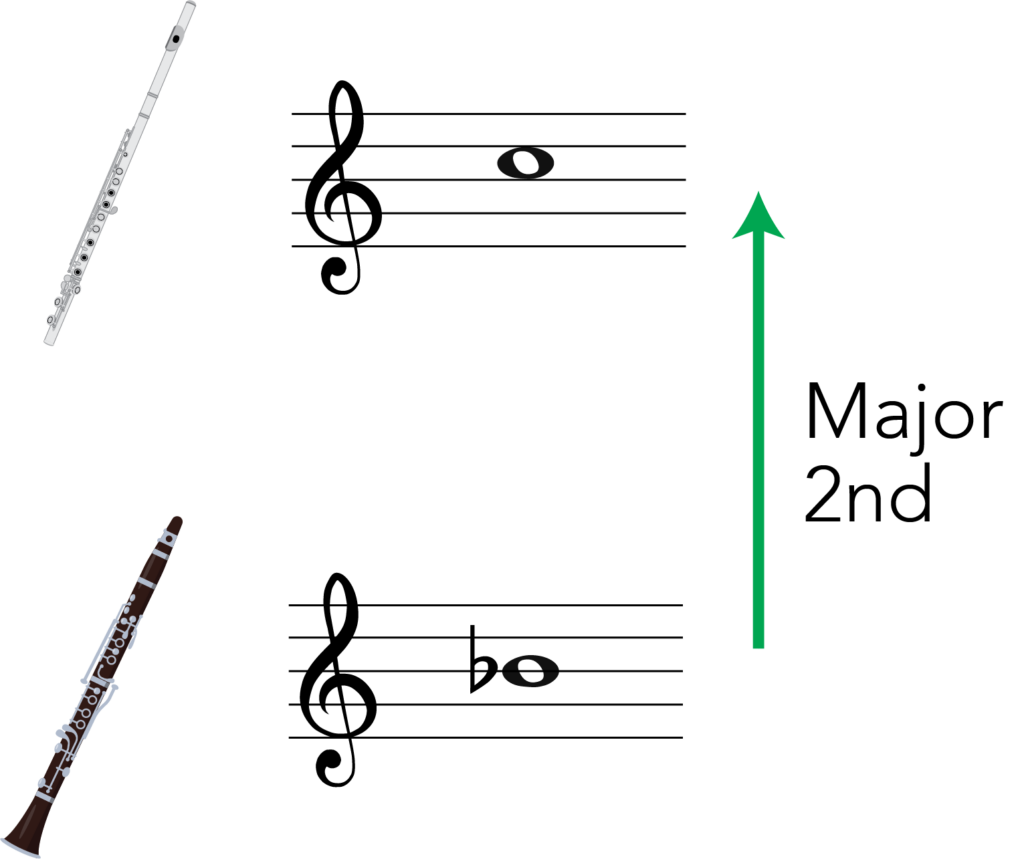
Transposition for clarinet in B flat to flute:
- Transpose down a major 2nd to play clarinet music on a the flute
- Transpose up a major 2nd to play flute music on a clarinet
- To have both instrument harmonising in the same key, we need the clarinet part to be a Major 2nd above the flute part.
Just like the clarinet, there are a family of flutes which include many transposing instruments. An example would be the alto flute which is in the key of G.
For more on transposing by a major 2nd see the section above about transposing from clarinet to piano.
Transpose clarinet to alto sax
The alto sax is a transposing instrument in the key of Eb. This means that it is a Major 6th below concert pitch. The clarinet is also a transposing instrument in B flat (a Major 2nd below concert pitch).
The interval of E flat to the B flat above is a Perfect 5th.
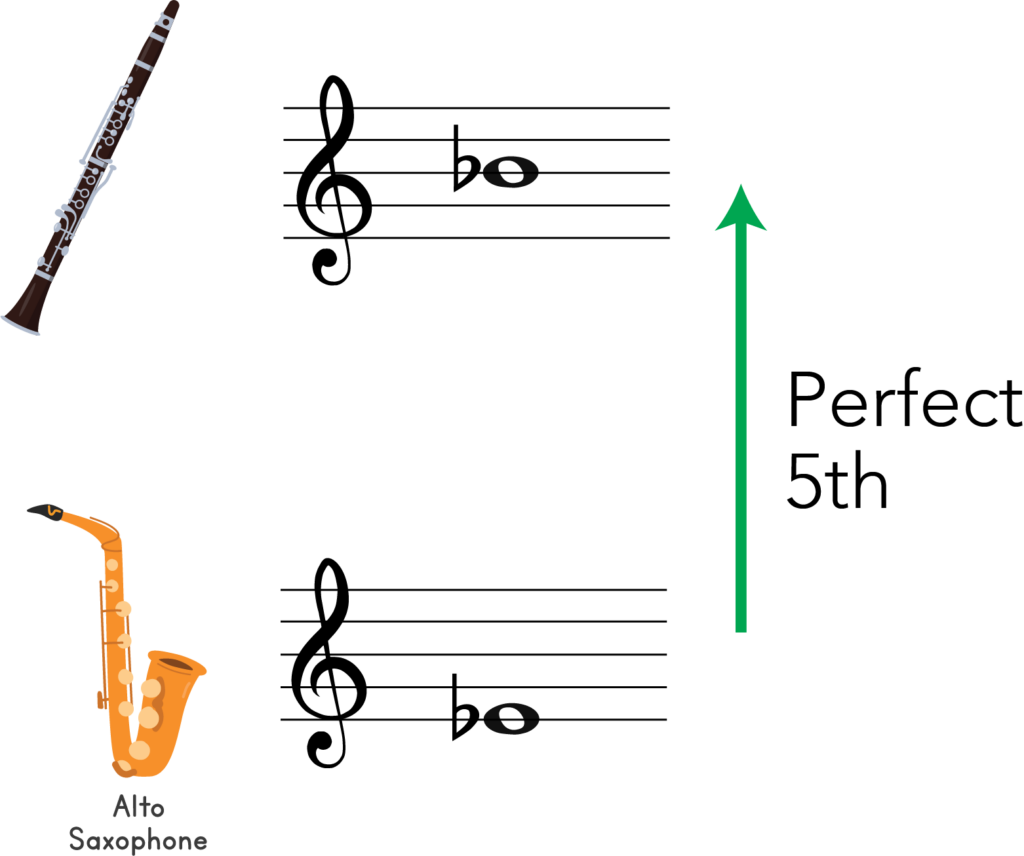
So why is transposing useful? Well, we might want to play music written for alto sax on the clarinet or we might want to write harmonising parts for both instruments. By transposing by a Perfect 5hth we can do this.
Transposition for clarinet in B flat to alto sax:
- Transpose up a Perfect 5th (7 half-steps) to play clarinet music on the alto sax.
- Transpose down a Perfect 5th to play alto sax music on the clarinet.
- To have both instrument harmonising in the same key, we need the alto sax part to be a Perfect 5th above the clarinet part.
So how do you transpose by a Major 2nd? We have two step-by-step guides to help: transpose up a Major 2nd and transpose down a Major 2nd.
Transpose Clarinet to French Horn
The French Horn is a transposing instrument in the key of F. This means that it is a perfect 5th below concert pitch. We know the clarinet is also a transposing instrument in B flat (a major 2nd below concert pitch).
The interval of F to the B flat above is a Perfect 4th, or 5 half-steps.

So why is transposing useful? Well, we might want to play music written for clarinet on the French horn or we might want to write harmonising parts for both instruments. By transposing by a Perfect 4th we can do this.
Transposition for clarinet in B flat to French Horn:
- Transpose down a Perfect 4th to play French horn music on the clarinet.
- Transpose up a Perfect 4th to play clarinet music on the French horn.
- To have both instrument harmonising in the same key, we need the French horn part to be a Perfect 4th above the clarinet part.
Need step-by-step examples of transposing by a perfect 4th? Check out our guides: transpose up a Perfect 4th and transpose down a Perfect 4th.
Transpose Clarinet to Guitar
The guitar is actually a transposing instrument because its sounding pitch is one octave below its written pitch. This means that when the guitar reads middle C on the staff, we will actually hear the C below this.
The clarinet is a transposing instrument in the key of Bb, so Bb to the C below gives us an interval of a Minor 7th. This is because Eb is the 7th note of the C minor scale.
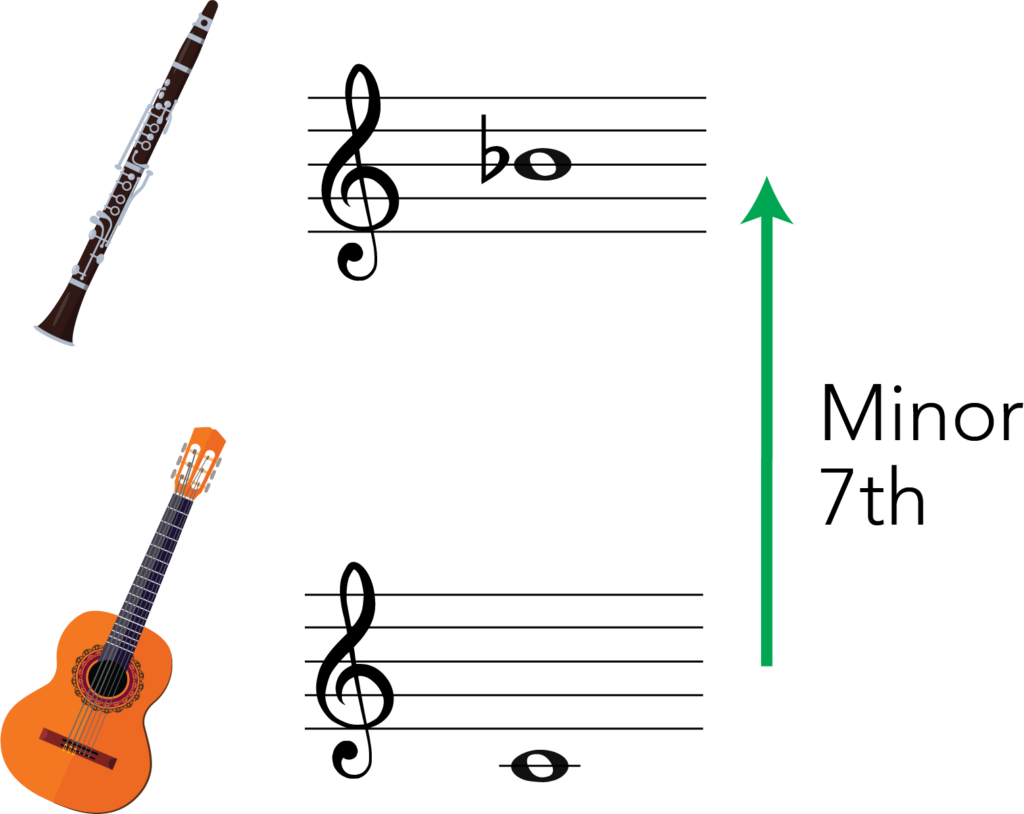
Transposition for clarinet in B flat to Guitar:
- Transpose up a Minor 7th to play clarinet music on the guitar.
- Transpose down a Minor 7th to play guitar music on the clarinet.
How to Transpose Clarinet to Violin
The violin is a non-transposing instrument that plays in concert pitch, or in the key of C. This means that like with the piano, we have to transpose by a major 2nd to move between clarinet and violin music.
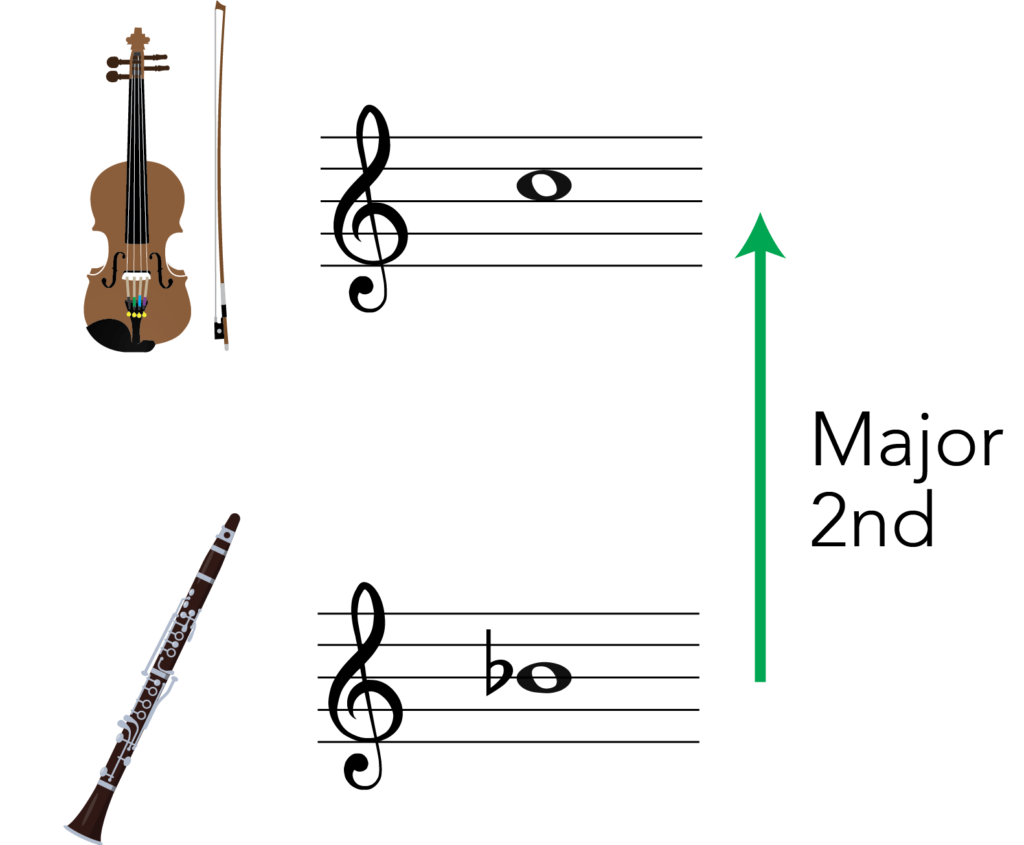
Transposition for clarinet in B flat to violin:
- Transpose down a major 2nd to play clarinet music on a violin.
- Transpose up a major 2nd to play violin music on a clarinet.
- To have both instrument harmonising in the same key, we need the clarinet part to be a Major 2nd above the violin part.
For more on transposing by a major 2nd see the section above about transposing from clarinet to piano.
Using computer software
A far quicker method of transposition is to use software to do it for you! Apps like Musescore, Sibelius and Finale will transpose whole pieces with the press of a few buttons. You can then export, print and share your new transposed sheet music.
What’s next….?
- Learn how to transpose with the A Clarinet.
- Check out our guides to transposition.
